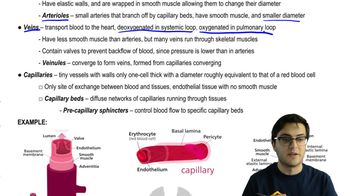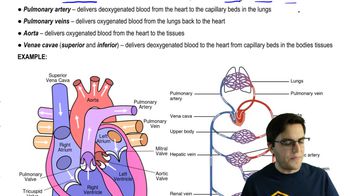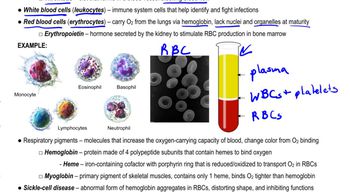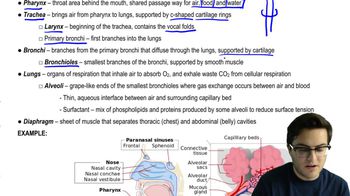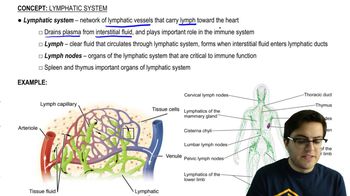>> The respiratory organs of aquatic animals are called gills, which in bony fish are covered by a stiff flap called the operculum. Here we've removed the operculum so that the gills are visible. Gills are outfoldings of the body's surface specialized for gas exchange. Because oxygen is far less plentiful in water than it is in air, the gills of active animals such as fishes must be very efficient to obtain enough oxygen. The gills in fish obtain oxygen from water as the water flows over the gills. Oxygen-rich water enters through the fish's open mouth, passes through slits in the pharynx, and flows across the gills, where oxygen diffuses from the water into the bloodstream. The oxygen-poor water then passes back out to the environment. A closer look reveals that the gills consist of multiple pairs of filaments supported by gill arches. As water flows through the gills, the filaments are surrounded by water. Notice that blood vessels run through the gill arch and branch into each filament. Red indicates that a blood vessel carries oxygen-rich blood. Blue indicates a vessel carrying oxygen-poor blood, blood whose oxygen has been depleted. Where is the oxygen-poor blood coming from? As blood circulates through the body tissues, oxygen is used; thus, the oxygen-poor blood comes from the body tissues, where it then returns to the heart, which pumps it to the gills. After the blood is recharged with oxygen in the gills, the blood continues on its journey and carries this oxygen to the body tissues. Next, let's take a closer look at a gill filament to see what happens to the oxygen-poor blood coming from the heart. Each gill filament bears many rows of plate-like lamellae that are the actual respiratory surfaces. Each lamella is full of tiny capillaries. Here we show the path of a single red blood cell as oxygen-poor blood coming from the heart flows through a larger vessel and then enters one of these capillary beds. Notice the color change of the cell from blue to purple to red as it travels through the capillary bed, picking up oxygen from the oxygen-rich water that flows through the gills. The red blood cell then enters the blood vessel at the other side of the capillary bed. Blood from that vessel flows into the larger vessel in the gill arch and then circulates to the body tissues. A process called countercurrent exchange makes fish gills highly efficient at extracting oxygen from the water. Countercurrent refers to the flow of two fluids, blood and water, in opposite directions. In our diagram, blood flows right to left through the capillaries. Water is moving in the opposite direction, left to right, as it flows through the gill filaments.
Table of contents
- 1. Introduction to Biology2h 40m
- 2. Chemistry3h 40m
- 3. Water1h 26m
- 4. Biomolecules2h 23m
- 5. Cell Components2h 26m
- 6. The Membrane2h 31m
- 7. Energy and Metabolism2h 0m
- 8. Respiration2h 40m
- 9. Photosynthesis2h 49m
- 10. Cell Signaling59m
- 11. Cell Division2h 47m
- 12. Meiosis2h 0m
- 13. Mendelian Genetics4h 41m
- Introduction to Mendel's Experiments7m
- Genotype vs. Phenotype17m
- Punnett Squares13m
- Mendel's Experiments26m
- Mendel's Laws18m
- Monohybrid Crosses16m
- Test Crosses14m
- Dihybrid Crosses20m
- Punnett Square Probability26m
- Incomplete Dominance vs. Codominance20m
- Epistasis7m
- Non-Mendelian Genetics12m
- Pedigrees6m
- Autosomal Inheritance21m
- Sex-Linked Inheritance43m
- X-Inactivation9m
- 14. DNA Synthesis2h 27m
- 15. Gene Expression3h 20m
- 16. Regulation of Expression3h 31m
- Introduction to Regulation of Gene Expression13m
- Prokaryotic Gene Regulation via Operons27m
- The Lac Operon21m
- Glucose's Impact on Lac Operon25m
- The Trp Operon20m
- Review of the Lac Operon & Trp Operon11m
- Introduction to Eukaryotic Gene Regulation9m
- Eukaryotic Chromatin Modifications16m
- Eukaryotic Transcriptional Control22m
- Eukaryotic Post-Transcriptional Regulation28m
- Eukaryotic Post-Translational Regulation13m
- 17. Viruses37m
- 18. Biotechnology2h 58m
- 19. Genomics17m
- 20. Development1h 5m
- 21. Evolution3h 1m
- 22. Evolution of Populations3h 52m
- 23. Speciation1h 37m
- 24. History of Life on Earth2h 6m
- 25. Phylogeny2h 31m
- 26. Prokaryotes4h 59m
- 27. Protists1h 12m
- 28. Plants1h 22m
- 29. Fungi36m
- 30. Overview of Animals34m
- 31. Invertebrates1h 2m
- 32. Vertebrates50m
- 33. Plant Anatomy1h 3m
- 34. Vascular Plant Transport2m
- 35. Soil37m
- 36. Plant Reproduction47m
- 37. Plant Sensation and Response1h 9m
- 38. Animal Form and Function1h 19m
- 39. Digestive System10m
- 40. Circulatory System1h 57m
- 41. Immune System1h 12m
- 42. Osmoregulation and Excretion50m
- 43. Endocrine System4m
- 44. Animal Reproduction2m
- 45. Nervous System55m
- 46. Sensory Systems46m
- 47. Muscle Systems23m
- 48. Ecology3h 11m
- Introduction to Ecology20m
- Biogeography14m
- Earth's Climate Patterns50m
- Introduction to Terrestrial Biomes10m
- Terrestrial Biomes: Near Equator13m
- Terrestrial Biomes: Temperate Regions10m
- Terrestrial Biomes: Northern Regions15m
- Introduction to Aquatic Biomes27m
- Freshwater Aquatic Biomes14m
- Marine Aquatic Biomes13m
- 49. Animal Behavior28m
- 50. Population Ecology3h 41m
- Introduction to Population Ecology28m
- Population Sampling Methods23m
- Life History12m
- Population Demography17m
- Factors Limiting Population Growth14m
- Introduction to Population Growth Models22m
- Linear Population Growth6m
- Exponential Population Growth29m
- Logistic Population Growth32m
- r/K Selection10m
- The Human Population22m
- 51. Community Ecology2h 46m
- Introduction to Community Ecology2m
- Introduction to Community Interactions9m
- Community Interactions: Competition (-/-)38m
- Community Interactions: Exploitation (+/-)23m
- Community Interactions: Mutualism (+/+) & Commensalism (+/0)9m
- Community Structure35m
- Community Dynamics26m
- Geographic Impact on Communities21m
- 52. Ecosystems2h 36m
- 53. Conservation Biology24m
40. Circulatory System
Circulatory and Respiratory Anatomy
Video duration:
3mPlay a video:
Related Videos
Related Practice



